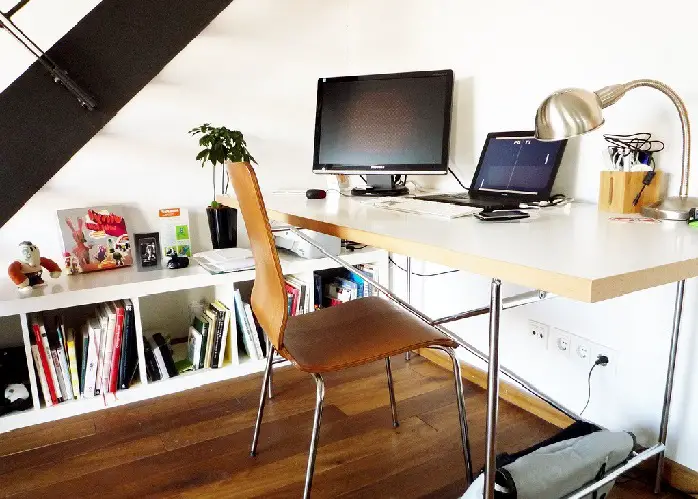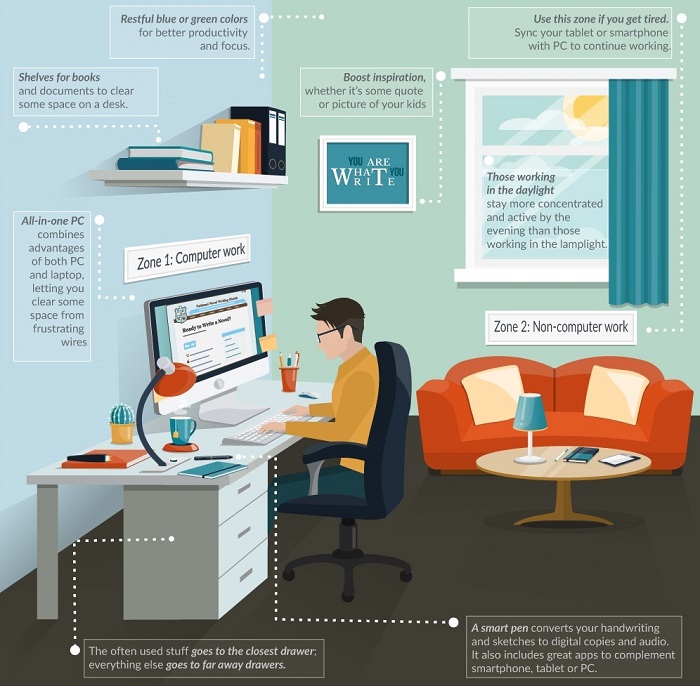With coworking and freelancing being the trend today, it’s no surprise that more and more people start paying attention to their workspace organization. And if it used to be enough to provide workers with tables, chairs, and computers, today everyone treats a comfortable and well-organized workplace as a high priority.
The reason is simple:
A place and surroundings where people work enhance productivity and increase their peace of mind. Hence, one should care about the place of work and setting up a virtual office if they want to stay inspired, motivated, and productive specialists with better results at work.
How to do that?
All workspace improvement recommendations revolve around five central themes:
- Color or overall feel from working at your spot
- Desk set up
- Lighting
- Ergonomics or how your body feels
- Zone-specific work and thought processes
Statistics says that only one in four U.S. workers is in optimal workplace environments. Others struggle to work well, resulting in lost productivity and engagement. It’s obvious that employees perform better when they can control their workspace, and a 2013 Workplace Survey from Gensler confirms this statement.
For those working from home, the problem of workspace organization is even more critical, as it’s hard to keep in mind all details and stay concentrated and productive in a cozy home environment. Emily Johnson from OmniPapers did her best to create a manual on workplace organization and reveals the urgency of this issue for freelancers.
To consider all aspects of workspace organization for better results, overall motivation, and enhanced productivity, one should take a cue from experts and make sure they consider the following:
Wall Color
Would you paint walls in a different color if you knew it helped with productivity? Maybe not right away. Such changes would be too structural and resource-demanding. It is a matter of simple cost effectiveness, whereby such changes as painting walls and buying specialized equipment require significantly more effort than the amount of potential good they carry, especially when you create your home office.
However, according to color psychologist Angela Wright, every color influences people universally despite their different color preferences. With that in mind, we should think of changing the wall color in the workspace if it doesn’t stimulate our productivity.
After checking the influence of every color, it becomes clear that blue and green are the best variants for a workspace to try: blue stimulates the mind while green creates a calming balance.
Desk
It’s not the only furniture to pay attention to, but nevertheless, it’s the most important one for performers.
First of all, one should get rid of clutter at the table:
- Things we don’t use daily go to drawers.
- Stickers help to make notes and organize thoughts.
Secondly, one should think of having the following items on the table:
- A cup of green tea allows to work smarter.
- A plant on the desk increases cognitive attention and productivity, according to numerous studies, such as this one from 2011 and this one from 2015, for example.
- All-in-one PC with a wireless keyboard and mouse is the best decision to organize work and perform faster.
Light
When it comes time to concentration and productivity, lighting appears to be a crucial aspect of workspace organization. This problem is debatable, as many believe that natural light encourages energy and creativity while others consider little lighting a reason individuals stay focused.
However, studies prove a positive effect of natural light, which lead us to bigger windows in offices, more desks at windows, and lamps with cold color temperatures of 3500-4000K as they stimulate the brain and can influence productivity.
Ergonomics
As clear as day, productivity and desire to work depend on properly adjusted tools at a workplace. Everyone, backed up by science, agrees that individuals will never perform well if sitting in uncomfortable chairs or working at improperly adjusted computer screens.
What can help to improve this aspect of workspace organization:
- Adjustment of the office chair
- Adjustment of the desk height
- Adjustment of the computer screen
- Using ergonomic chairs that support lower back
- Using elliptical trainers to impact different muscles groups
Good furniture is not enough to have if a person spends the whole day sitting. According to a study by health science officer Nicolaas P. Pronk, standing work influences our health and productivity better. So, the ideal variant would be to buy a standing/sitting desk that transforms and gives an opportunity to change position anytime. Or, standing up every 20 minutes for at least two minutes would reduce a risk of heart diseases, too.
Breaking into Zones
In a perfect world, every workspace would be divided into two zones:
- A computer corner for spending the essential part of a working day there
- A non-computer corner for relaxing and gaining inspiration. This zone is a perfect place for cozy sofas, favorite books, motivational quotes, etc.
If it is possible to do that, performers should think of including this aspect to their plan of organizing a workplace.
Surroundings play far from the last role in encouraging performers. If we pay more attention to our workspace organization, we will get better results, working productively and with inspiration.
Author bio: Clifford Meridith is a freelance writer and novelist who has been working full-time for 15+ years. Now his focus is a workplace organization, so he provides freelancers with useful advice on the topic. You can always contact him on Google+ or drop him a line via email: clifford.meridith@gmail.com.



Leave a Reply